|
A Brief Introduction to China
|

|
|
General Information
|
|
China is situated in eastern Asia, bounded by the Pacific in the east. The third
largest country in the world, next to Canada and Russia, it has an area of 9.6 million
square kilometers, or one-fifteenth of the world's landmass. It begins from the
confluence of the Heilong and Wusuli Rivers (135 degrees and 5 minutes east longitude)
in the east to the Pamirs west of Wuqia County in Xinjiang Uygur Autonomous Region
(73 degrees and 40 minutes east longitude) in the west, with about 5,200 kilometers
apart. In the north, it starts from the midstream of the Heilong River north of
Mohe (53 degrees and 31 minutes north latitude) and stretches south to the southernmost
island Zengmu'ansha in the South China Sea (4 degrees and 15 minutes north latitude),
with about 5,500 kilometers in between.
The Chinese border stretches over 22,000 kilometers on land and its coastline extends
well over 18,000 kilometers, washed by the waters of the Bohai Sea, the Huanghai,
the East China and the South China Seas. The Bohai Sea is China’s only inland sea.
There are 6,536 islands larger than 500 square meters, the largest being Taiwan,
with a total area of about 36,000 square kilometers, and the second, Hainan. The
South China Sea Islands are the southernmost island group of China.
|
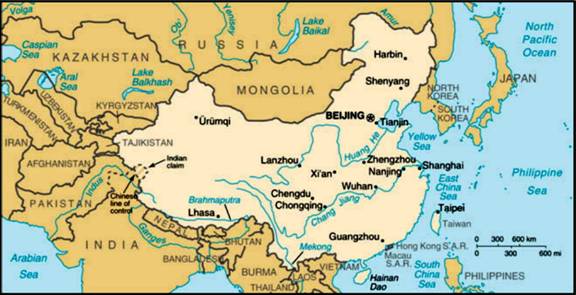
|
|
Map is from the CIA World Factbook
|
|
History
|
|
The
Dynasties
|
|
Dynasty
|
Date
|
|
Xia
|
2070-1600 B.C.
|
|
Shang
|
1600-1046 B.C.
|
|
Western Zhou
|
1046-771 B.C.
|
|
Eastern Zhou
|
|
|
Spring and Autumn Period
|
770-476 B.C.
|
|
Warring States Period
|
475-221 B.C.
|
|
Qin
|
221-206 B.C.
|
|
Western Han
|
206 B.C.-A.D. 24
|
|
Eastern Han
|
25-220
|
|
Three Kingdoms (Wei, Shu and Wu)
|
220-265
|
|
Western Jin
|
265-316
|
|
Eastern Jin
|
317-420
|
|
Southern and Northern Dynasties
|
420-589
|
|
Sui
|
581-618
|
|
Tang
|
618-907
|
|
Five Dynasties
|
907-960
|
|
Northern Song
|
960-1127
|
|
Southern Song
|
1127-1279
|
|
Yuan
|
1271-1368
|
|
Ming
|
1368-1644
|
|
Qing
|
1644-1911
|
|
|
Prehistoric and Ancient History (1.7 million years ago-476 B.C.)
China's earliest primitive human discovered so far is known as "Yuanmou Man,"
a fossil anthropoid unearthed in Yuanmou in Yunnan Province who lived approximately
1.7 million years ago. The better-known "Peking Man," discovered in the
Zhoukoudian area in the suburbs of Beijing, lived about 600,000 years ago. Peking
Man was able to walk upright, make and use simple tools, and make fire. By the start
of the Neolithic Age in China about 10,000 years ago, people were cultivating rice
and millet with farming tools, something revealed by relics found in the ruins of
Hemudu in Yuyao, Zhejiang Province, and Banpo, near Xi'an City, Shaanxi Province.
The Hemudu site, about 7,000 years old, was one of the earliest New Stone Age locations
along the lower reaches of the Yangtze River. Archaeologists have unearthed in the
area of Hemudu piles of rice grains, husks, stalks and leaves — and other indications
of abundant rice cultivation. The rice grown at Hemudu was long-grained non-glutinous
rice, and is the earliest example of artificially cultivated rice that has been
found in China to date. The relics are also the oldest rice found so far in Asia.
The Xia Dynasty started in 2070 B.C. The center of Xia was the western section of
modern Henan Province and the southern section of modern Shanxi Province with a
sphere of influence that reached the northern and southern areas of the Yellow River.
It was in this period that the slave society began to appear. The Xia Dynasty was
overthrown by Shang. The Western Zhou (1046-771 B.C.) Dynasty saw further development
of slave society. This era was followed by the Spring and Autumn (770-476 B.C.)
and Warring States (475-221 B.C.) periods when silk production advanced and steel
production started. This era also produced the philosophers Lao Zi, Confucius, Mencius
and Mo Zi, as well as the military scientist Sun Wu, author of the Art of War.
Qin Dynasty (221-206 B.C.)
In 221 B.C., Ying Zheng, ruler of the State of Qin and a man of great talent
and bold vision, ended the 250-odd years of rivalry among the independent principalities
during the Warring States Period, and established the first centralized, unified,
multi-ethnic feudal state in Chinese history — the Qin Dynasty (221-206 B.C.). He
called himself Qin Shi Huang or "First Emperor of Qin." He standardized
the written script, weights and measures, and currencies, and established the system
of prefectures and counties. The sovereigns of the next 2,000-odd years followed
the feudal governmental structure established by him. He mobilized more than 300,000
people over a period of a dozen years to build the Great Wall, which stretches for
5,000 km in northern China. Qin Shi Huang had the work on his enormous mausoleum
started early in his reign. When they were unearthed in 1974 in Xi'an, the terracotta
warriors of the "underground army" of some 8,000 vivid, life-sized pottery
figures, horses and chariots guarding the mausoleum at the Qin Shi Huang tomb site
amazed the world.
Han Dynasty (206 B.C.-A.D. 220)
Liu Bang established the powerful Han Dynasty in 206 B.C. During the Han Dynasty,
agriculture, handicrafts and commerce flourished, and the population reached 50
million. During the most prosperous period of the Han Dynasty, Emperor Wudi (140-87
B.C.) expanded from the Central Plains to the Western Regions (present-day Xinjiang
and Central Asia). Emperor Wudi dispatched Zhang Qian twice as his envoy to the
Western Regions, and in the process pioneered the route known as the "Silk
Road" from Chang'an (today's Xi'an, Shaanxi Province), through Xinjiang and
Central Asia, and on to the east coast of the Mediterranean Sea. China's silk goods
were traded to the West along the Silk Road. As contacts between the East and West
increased, Buddhism spread to China in the first century. In 105, an official named
Cai Lun invented a technique for making fine paper, leading to a revolution in communications
and learning.
Tang Dynasty (618-907)
After the Han Dynasty came the Three Kingdoms Period (220-265), the Jin Dynasty
(265-420), the Southern and Northern Dynasties (420-589) and the Sui Dynasty (581-618).
Then came the Tang Dynasty, established by Li Yuan in 618 with its capital at Chang'an
(Xi'an). Agriculture, handicrafts and commerce flourished; technologies for textile
manufacturing and dyeing, pottery and porcelain production, smelting and shipbuilding
were further developed. Woodblock printings of dictionaries and almanacs and Buddhist
scriptures were in circulation. The Grand Canal also helped the flow of merchandise.
Chang'an became a cultural and international trade center and — along with Luoyang,
Yangzhou, and Guangzhou — a major commercial center. During the Tang Dynasty cultural
relations were established with many countries, including Japan, Korea, India, Persia
and Arabia. By the 660s, China's influence had firmly taken root in the Tarim basin
and Ili River valley in today's Xijiang in the West, even extending to many city-states
in Central Asia.
Song, Yuan, Ming and Qing Dynasties (960-1911)
Following the Tang Dynasty came a period of almost continual warfare known as the
Five Dynasties and Ten States. In 960, Zhao Kuangyin, a general of the State of
Later Zhou, established the Song Dynasty (960-1279), known in history as the Northern
Song Dynasty. When the Song Dynasty moved its capital to the south, it became known
in history as the Southern Song Dynasty. China in the Song Dynasty was in the forefront
of the world in astronomy, science and technology. Bi Sheng invented movable type
printing in the 1040s, ushering in a major revolution in the history of printing.
In 1206, Genghis Khan established the Mongolian Khanate. In 1271, Kublai, a grandson
of Genghis Khan, conquered the Central Plains, founded the Yuan Dynasty (1271-1368),
and made Dadu (today's Beijing) the capital. Kublai ended the centuries-long situation
in which many independent regimes existed side by side by forming a united country
that brought Xinjiang, Tibet and Yunnan under its sway. During the Song-Yuan period,
the "four great inventions" in science and technology of the Chinese people
in ancient times — papermaking, printing, the compass and gunpowder — were further
developed, and spread abroad.
In 1368, Zhu Yuanzhang established the Ming Dynasty (1368-1644) in Nanjing, reigning
as Emperor Taizu. When his son and successor Zhu Di (1360-1424) ascended the throne,
he built and expanded the palaces, temples, city walls and moats in Beijing. In
1421, he officially moved the capital to Beijing. During his reign, he dispatched
a eunuch named Zheng He to lead a fleet of many ships to make seven far-ranging
voyages. Passing the Southeast Asian countries, the Indian Ocean, Persian Gulf and
Maldives Islands, Zheng He explored as far as Somalia and Kenya on the eastern coast
of Africa. These were the largest-scale and longest voyages in the world before
the age of Columbus.
The Manchus of northeast China established the Qing Dynasty (1644-1911) in 1644.
The best known of the Qing Dynasty emperors, Kangxi (r. 1661-1722) restored the
central empire's rule over Taiwan, and resisted invasions by tsarist Russia. To
reinforce the administration of Tibet, he also formulated the rules and regulations
on the confirmation of the Tibetan local leaders by the Central Government. He effectively
administered over 11 million sq km of Chinese territory.
|
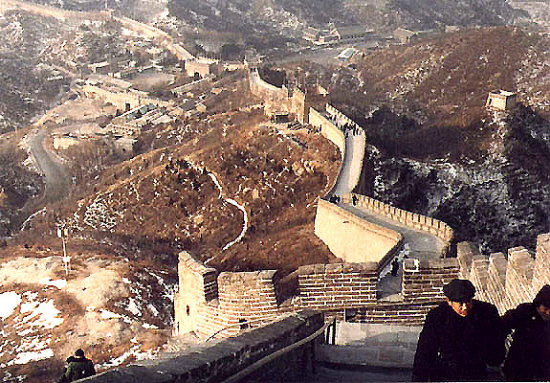
|
|
Modern China
|
|
Modern Period (1840-1919)
During the early 19th century, the Qing Dynasty declined rapidly. Britain smuggled
into China large quantities of opium, and in response the Qing government imposed
a ban on the drug. In an effort to protect its opium trade, Britain launched a war
against China in 1840, which led to the Qing government's signing with the British
government the Treaty of Nanking, a treaty of national betrayal and humiliation.
Many countries, including Britain, the United States, France, Russia and Japan forced
the Qing government to sign various unequal treaties following the Opium War. China
was gradually relegated to a semi-colonial, semi-feudal country.
The Revolution of 1911 led by Dr. Sun Yat-sen was one of the greatest events in
modern Chinese history, as it overthrew the 200-odd-year-old Qing Dynasty, ending
over 2,000 years of feudal monarchy, and established the Republic of China.
New-Democratic Revolution (1919-1949)
The May 4th Movement of 1919 is regarded as the ideological origin of many important
events in modern Chinese history. Its direct cause was the unequal treaties imposed
on China after the First World War. Out of strong patriotism, students initiated
the movement, and it further developed into a national protest movement of people
from all walks of life. It also marked the introduction into China of various new
ideologies, among which the spread of Marxism-Leninism was worthy of special mention.
Under the influence of Russia's October Revolution of 1917, 12 delegates, including
Mao Zedong, representing Communist groups in different places throughout the nation,
held the First National Congress in Shanghai in 1921 to found the Communist Party
of China.
The Chinese people led by the CPC underwent successively the Northern Expeditionary
War (1924-27), War of Agrarian Revolution (also known as "Ten-Year Civil War,"
1927-37), War of Resistance Against Japan (1937-45) and War of Liberation (1945-49).
Owing to the cooperation and joint resistance of the CPC and Kuomintang, the Japanese
aggressors were defeated. But shortly after the anti-Japanese war, the Kuomintang
launched a civil war. After the three-year War of Liberation led by the CPC, the
Kuomintang government was overthrown in 1949.
People's Republic of China (1949- )
|
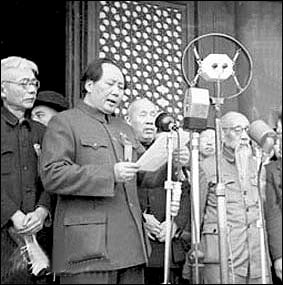
|
|
On October 1, 1949 a grand ceremony was witnessed by 300,000 people in Beijing's
Tiananmen Square, and Mao Zedong, chairman of the Central People's Government, solemnly
proclaimed the founding of the People's Republic of China.
During the initial post-Liberation period, the Chinese government successfully carried
out land reform in areas accounting for over 90 percent of the total national agricultural
population, and 300 million farmers were granted approximately 47 million ha of
land. Amazing achievements were made during the First Five-Year Plan period, from
1953 to 1957. The average annual increase rate of the national income reached over
8.9 percent. China established basic industries necessary for full industrialization
hitherto non-existent domestically, producing airplanes, automobiles, heavy machinery,
precision machinery, power-generating equipment, metallurgical and mining equipment,
high-grade alloy steels and non-ferrous metals.
The ten years from 1957 to 1966 was the period in which China started large-scale
socialist construction. Though China suffered from the mistakes in its policies
during the period, it also accomplished a great deal. The nation's total industrial
fixed assets quadrupled between 1956 and 1966 and the national income increased
by 58 percent in constant prices. The output of essential industrial products increased
by several or even a dozen times. Large-scale agricultural capital construction
and technical transformation got underway. Unfortunately, the "cultural revolution,"
which lasted for ten years (1966-1976), made the state and its people suffer the
most serious setbacks and losses since its founding.
The Jiang Qing counter-revolutionary clique was smashed in October 1976, marking
the end of the "cultural revolution," and the beginning of a new era in
Chinese history. The CPC reinstated Deng Xiaoping, previously general secretary
of the CPC, to all the Party and governmental posts he had been dismissed from during
the "cultural revolution." In 1979, China instituted a guiding policy
of "reform and opening to the outside world" under Deng's leadership,
and the focus was shifted to modernization. Major efforts were made to reform the
economic and political systems. China was step by step establishing a road with
Chinese characteristics, a road that would lead to socialist modernization. Profound
changes have come about in China since the country embarked on the policy of reform
and opening-up characterized by a vigorously advancing economy and markedly improved
living standard.
Jiang Zemin became general secretary of the CPC Central Committee in 1989 and head
of the state in 1993. Succeeding him, Hu Jintao took the position of general secretary
of the CPC Central Committee in 2002 and president of the state in 2003.
Structure of Government
A.Executive Branch
The positions and powers of the President and the Vice President are established
in Articles 79-84 in the Constitution of the People’s Republic of China (1982).
The NPC elects individuals to fill these positions for a term of five years with
a limit of two consecutive terms (Art. 79).Some of the powers entrusted to the President
are the promulgation of statutes, the appointment and removal of various State Council
members, the issuance of pardons, proclamations of martial law and states of war,
as well as receiving foreign diplomats and ratifying or abrogating treaties with
foreign nations (Arts. 80-81).The Vice President is to aid the President in carrying
out his duties, and may carry out presidential functions delegated by the President
(Art. 82).
The State Council is the government of the PRC under the authority of Articles 85-98.It
is the highest organ of state power, and of state administration (Art. 85). The
State Council consists of the Premiers, Vice-Premiers, State Councillors, Ministers
in charge of ministries, Ministers in charge of commissions, Auditor-General, and
the Secretary-General.The State Council’s term of office is five years (Art. 86).
The State Council is given a number of functions and powers, including but not limited
to: the adoption of administrative measures, rules and orders, submission of proposals
to the NPC,creation and execution of a plan for national economic and social development,
conducting foreign affairs and concluding treaties and agreements with foreign nations;
protection of the rights of Chinese nationals abroad, and exercising any other functions
that the NPC may delegate to it (Art. 89).
B.Legislative Branch
|
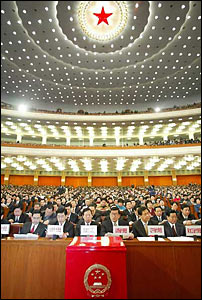
|
|
The National People's Congress ("NPC") and local people's congresses at
all levels, formed through democratic elections, represent the people in exercising
state power. People's congresses are the basic units of political power in China,
and the NPC and its Standing Committee exercise the highest level of this state
legislative power. The people's congress system is responsible for creating and
supervising all administrative, judicial and procuratorial units at every level
of government. The system was established following the meeting of people's congresses
at different levels in 1953, and then convened in 1954 in the First National People's
Congress.
Deputies to county and township people's congresses are directly elected. Deputies
to people's congresses above the county level are elected by deputies at lower levels.
The NPC deputies are supervised by delegates at lower levels, and are ultimately
responsible to the people, who can recall them. The NPC is empowered to examine
and approve the national economic and social development plans and the reports on
their implementation. It is also responsible for examining and approving the state
budget and the report on its implementation during its annual meeting.
All administrative, judicial, prosecutorial and military agencies and other state-level
institutions are responsible to the NPC and supervised by it. The legislative powers
of the NPC include electing the President of China, supervising the enforcement
of the Constitution, amending the Constitution, enacting basic laws, deciding on
the choice of the Premier of the State Council upon nomination by the President,
electing the Chairman of the Central Military Commission and, upon nomination by
the Chairman, deciding on the choice of all other members of the Central Military
Commission, and electing the President of the Supreme People's Court. The NPC meets
once a year for about two weeks. Between these sessions, its power is exercised
by its Standing Committee, elected by NPC members, which is responsible to the NPC
and reports its work to the NPC. The current Chairman of the NPC Standing Committee
is Wu Bangguo.
C.Judicial Branch
The judicial system of the PRC is established in Articles 123-135,and consists of
the people’s courts, the Supreme People’s Court, the people’s procuratorates, the
Supreme People’s Procuratorate, military procuratorates and other special people’s
procuratorates.Article 129 refers to the people’s procuratorates as “state organs
for legal supervision.” The Supreme People's Procuratorate, accountable to the NPC
and its Standing Committee, is the highest prosecutorial agency in China exercising
and supervising prosecutorial authority at all state and local levels. Procuratorates
examine cases scheduled for investigation by public security agencies to decide
whether a suspect should be arrested or not, and whether a case should be prosecuted
or not. They institute and support public prosecution in criminal cases; and oversee
the activities of the public security and state security agencies, people's courts,
prisons, houses of detention and reform-through-labor institutions. The Prosecutor
General of the Supreme People's Procuratorate is Jia Chunwang.
There is a hierarchy within the court structure from the top down: The Supreme People’s
Courts, the Higher People’s Courts, the Intermediate People’s Courts, and the Basic
People’s Courts.The Basic People’s Courts are comprised of more than 3,000 courts
at county level, which are further subdivided into about 20,000 smaller units referred
to as people’s tribunals located in towns and villages. There are 376 Intermediate
People’s Courts and 31 Higher People’s Courts located in the provinces. Additionally,
there are a number of specialized courts, for example those dealing with railway
transportation, forest affairs, the People’s Liberation Army (PLA) and maritime
issues. Jurisdiction is allocated partially through the Constitution, the 1979 Organic
Law of the People’s Courts, the Law of Criminal Procedure, the Law of Civil Procedure,
and the Law of Administrative Procedure.
Litigants are generally limited to one appeal, on the theory of finality of judgment
by two trials.Cases of second instances are often reviewed de novo as to both law
and facts.Requests for appellate review take the form of appeals and protests (in
criminal cases).Appeals are lodged by parties to the case, defendants and private
prosecutors.Protests are filed by the procuratorate in criminal cases when it is
believed that an error has occurred in the law or facts as determined by the judgment
or order of the court of first instance.In civil cases the procuratorate does not
possess a right to file a direct protest, but it can initiate adjudication supervision
via a protest. Adjudication supervision refers to a type of discretionary post-“final”
decision review, which may occur in certain situations in criminal cases.
|
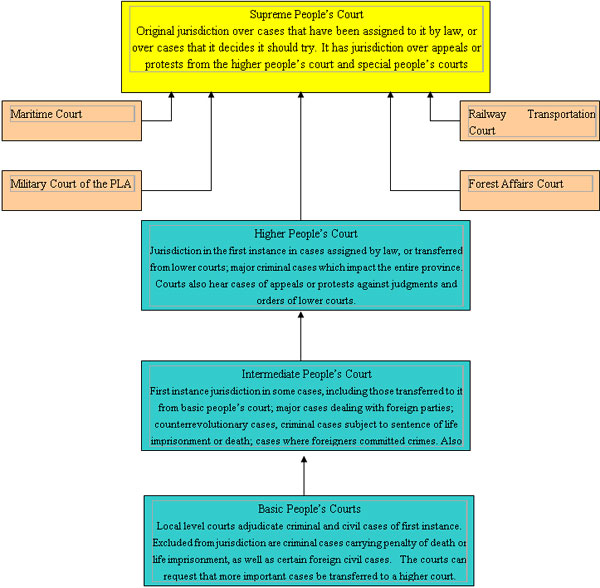
|
D.The Central Military Commission
The Central Military Commission is the nation's leading military agency and head
of its armed forces. The armed forces of the PRC consist of the Chinese People's
Liberation Army ("PLA"), the Chinese People's Armed Police Force and the
Militia. The PLA is the standing army of the state. The main tasks of the Armed
Police Force include performing guard duties and maintaining public order. The Militia
is an armed force of citizens who, when not on duty, remain engaged in their normal
work and life. The Chairman of the Central Military Commission is Jiang Zemin. On
March 16, 2003, the First Session of the 10th NPC, in accordance with nominations
of Chairman Jiang Zemin, approved Hu Jintao, Guo Boxiong and Cao Gangchuan as vice
chairmen and Xu Caihou, Liang Guanglie, Liao Xilong and Li Jinai as members of the
CMC.
|
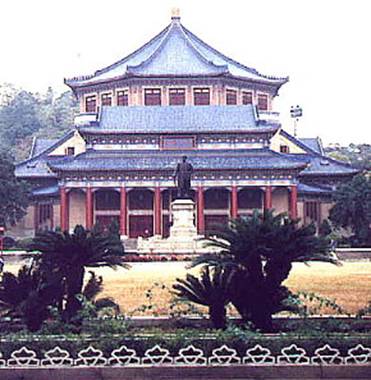
|
|
Sources of Law
|
|
A.1982 Constitution of the People’s Republic of China (Zhonghua Renmin Gongheguo
Xianfa)
The Constitution of the PRC guarantees the basic rights and interests of citizens,
including the right to vote and to stand for election; freedom of speech, of the
press, of assembly, of association, of procession and of demonstration; freedom
of religious belief; the inviolability of the freedom of the person, the personal
dignity and the residences; freedom and privacy of correspondence; the right to
criticize and make suggestions to any state agency or functionary and exercise supervision;
the right to work and rest and the right to material assistance from the state and
society when they are old, ill or disabled; and the right to receive education and
freedom to engage in scientific research, literary and artistic creation and other
cultural pursuits.
Adopted in 1982, China's Constitution has been amended for four times, most recently
this year on March 14, 2004 when the National People's Congress voted to include
formal guarantees of human rights — "the state respects and safeguards human
rights" — and private property. The clause on private property protection places
private assets of Chinese citizens on an equal footing with public-sector property,
"not to be encroached upon." Other major amendments to the Constitution
included an institution of the guiding role of the "Three Represents"
important thought in national political and social life, expressions of coordinated
development of material civilization and political and cultural progress, incorporation
of the term "builders of socialism," and improvement of the land expropriation
system.
B.NPC Statutory Law and Other Legislative Enactments
Over the past six years, China has intensified legislative action on enacting and
revising laws and regulations in accordance with its having become in late 2001
a member of the World Trade Organization ("WTO"). Up to the end of 2003,
around 440 laws and law-related decisions enacted by the National People's Congress
and its Standing Committee, more than 1,000 administrative regulations enacted by
the State Council and 10,000 local ordinances had been formulated. Those laws, regulations
and rules applying to a wide range of areas have helped to establish a relatively
complete system of law in China.
In 2003, China made unusual progress in its effort to improve its legal system.
First, the Standing Committee of the National People's Congress unanimously adopted
the Amendment to the Constitution of the People's Republic of China that was then
approved in March 2004 by the National People's Congress.
Second, the former "Measures for Internment and Deportation of Urban Vagrants
and Beggars" was replaced by the "Measures for the Assistance and Administration
of Persons Without Assured Living Sources in Cities," the words in the titles
reflecting the social progress contained within the measures. On August 1, 2003,
a regulation that provides voluntary shelter for vagrants and beggars went into
effect, demonstrating China's efforts to safeguard the civil rights of both migrants
and homeless people in urban areas. The new measures came more than a month after
the Chinese Central Government abolished a 20-year-old regulation that allowed police
to round up people without identification cards at will. Under the new regulation,
police are not allowed to imprison migrants without identification cards as vagrants.
Instead, police have the duty to "inform beggars and vagrants that they can
ask for help from shelters." This underlies the voluntary basis of the new
relief system rather than the so-called "holding system" previously in
force.
Third, the new Regulations on Marriage Registration was enacted, replacing old regulations
considered obsolete. Under the new regulations, couples need only show their ID
cards and residency papers and sign a document stating they are not married or related
to register their marriages, thus ending the involvement of "Danwei" or
the state-owned working units, which was previously essential.
C.International Treaties
The 1982 Constitution does not specify the treatment of international law in relation
to the laws of the PRC. However, in practice the legislative approach has been to
automatically incorporate international law as part of PRC law. If, however, the
PRC has made a reservation to a provision of a treaty, this aspect or provision
of the treaty is not implemented in the law.
D. Case Law
Unlike common law jurisdictions such as the United States or England, there is no
strict precedential concept for case law.In theory, each case stands as its own
decision and will not bind another court.However, in practice lower people’s courts
judges often attempt to follow the interpretations of the laws decided by the Supreme
People’s Courts. Moreover, higher courts can use the finality of their judgments
on appeals as having a binding effect on the lower court that issued the first judgment
or order.
|
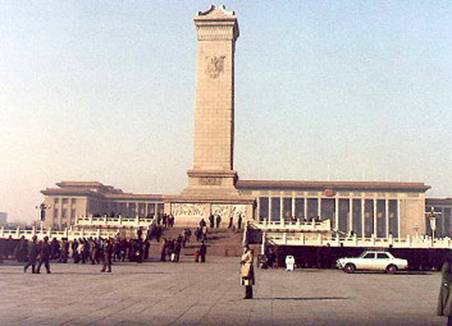
|
|
Legal System of China
|
|
The judiciary in China has both broad and narrow meanings. Broadly speaking, the
judiciary means law-enforcement activities conducted by the country's judicial organs
and organizations in handling prosecuted or non-prosecuted cases. Narrowly speaking,
it applies to law-enforcement activities conducted by the country's judicial organs
in handling prosecuted cases. This presentation uses the term in the broader sense.
Judicial organs here mean public-security organs (including state security organs)
responsible for investigation, prosecution, trial and execution of cases, the prosecutors,
the trial institutions and the custodial system. Judicial organizations here refer
to lawyers, public notaries, and arbitration organizations. The latter, though not
part of the judicial apparatus, are an integral part and a link in the overall judiciary
system.
The judiciary system in general refers to the nature, mission, organizational setup,
principles and procedures of judicial organs and other judicial organizations. This
system comprises sub-systems for investigation, prosecution, trial procedures, jails,
judicial administration, arbitration, lawyers, public notaries and state compensation.
|
|
|
|
|
|